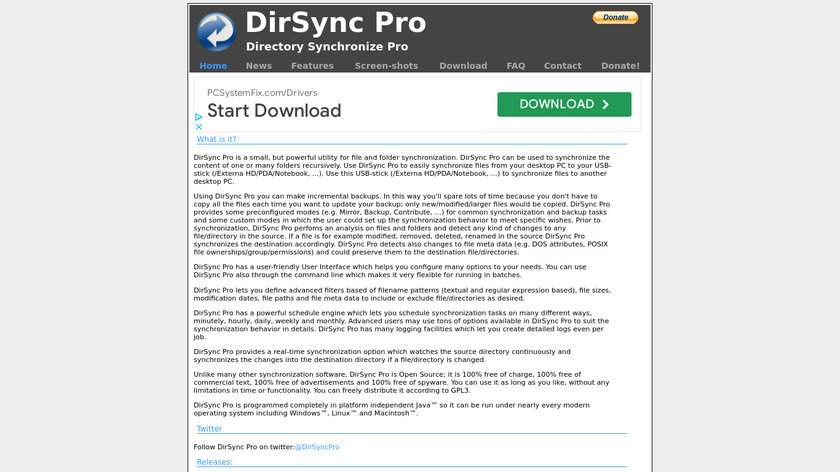

- FREEFILESYNC VS REALTIMESYNC HOW TO
- FREEFILESYNC VS REALTIMESYNC UPDATE
- FREEFILESYNC VS REALTIMESYNC DOWNLOAD
- FREEFILESYNC VS REALTIMESYNC FREE
To do that, open FreeFileSync and save the last session as a Batch job by clicking on the appropriate icon. I personally use HGST 4To drives after having read the reliability results from Backblaze’s website, which is a cloud storage company using consumer grade hard drives in their servers. They upload each quarter the reliability results from each of their drive pools and HGST always places among the bests in regards to low failure rates. In a low intensity scenario as is mine (the disks are only spun up a couple times a month at best), it’s perhaps not necessary to have the best reliability but it’s certainly a peace of mind and a way to limit risks. For the same reason, I don’t use external drives as I recall having read that the drives used are the ones failing the standards for desktop use and are therefore lower grade and more likely to fail. Isn’t that exciting? Let me know your thoughts on FreeFileSync in the comments down below.The two disks are protected and stored in plastic cases padded with foam. Wrapping UpĪnother open source file synchronization tool is Syncthing that you might want to look at.įreeFileSync is a pretty underrated folder comparison and sync tool available for Linux users who utilize Google Drive, SFTP, or FTP connections along with separate storage locations for backup.Īnd, all of that - with cross-platform support for Windows, macOS, and Linux available for free.

So, if you make any changes on the source/target folder, the modification will be synchronized.įor more advanced usage, I suggest you to refer the documentation available. There’s also a “Two-way” sync method which detects changes on both source and target folder (instead of monitoring just the source folder). So, here, if you delete something from your source, it gets deleted from your target folder as well. In case you want the target folder to have the same file copies of your same folder, you can choose the “Mirror” synchronization method. So, even if you delete something from your source folder, it won’t get deleted on your target folder. When you select “Update” method for sync, it simply copies your new data from the source folder to the target folder. Once you do that, you need to tweak the type of folder comparison you want to do (usually the file time & size) for the synchronization process and on the right-side, you get to tweak the type of sync that you want to perform. You can choose a local folder or a cloud storage location. The official documentation should be more than enough to get what you want using the software.īut, just to give you a head start, here are a few things that you should keep in mind.Īs you can see in the screenshot above, you just have to select a source folder and the target folder to sync. While I haven’t tried successfully creating an automatic sync job, it is pretty easy to use.
FREEFILESYNC VS REALTIMESYNC HOW TO
Next, you just need to extract the archive and run the executable file to get started (as shown in the image above)ĭownload FreeFileSync How To Get Started With FreeFileSync
FREEFILESYNC VS REALTIMESYNC DOWNLOAD
If you like you can download the source as well. You can simply head on to its official download page and grab the tar.gz file for Linux. So, that is definitely not bad! Installing FreeFileSync on Linux The premium features are mostly for advanced users and of course, if you want to support them (please do if you find it useful).Īlso, do note that the donation edition can be used by a single user on up to 3 devices. So, most of the essential features is available for free.
FREEFILESYNC VS REALTIMESYNC FREE
Here’s what different between the free and paid version: However, it does give you the option to opt for a donation key which unlocks some special features like the ability to notify you via email when the sync completes and so on.
FREEFILESYNC VS REALTIMESYNC UPDATE
You also get numerous synchronization options to mirror or update your data. For instance, you can compare the file content / file time or simply compare the file size of both source and target folder. So, if you take a look at the features it offers, it’s not just any ordinary sync tool but offers so much more for free.Īlso, to give you an idea, you can also tweak how to compare the files before syncing them. Get notified via email when sync completes (paid).Version control available for advanced users.Two-way synchronization supported (changes will be synced if there’s any modification on the target folder or the source folder).


I’ll highlight all the features I can here: Even though the UI of FreeFileSync might look old school - it offers a ton of useful features for average users and advanced users as well.


 0 kommentar(er)
0 kommentar(er)
